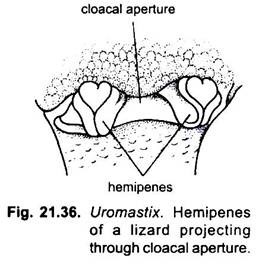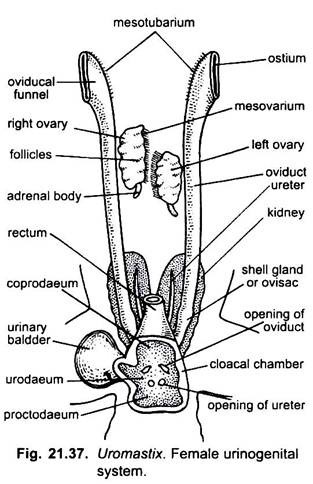In Uromastix, the excretory and reproductive systems are closely associated as in other vertebrates. Therefore, the two systems are described together under the heading urinogenital system. The sexes are separate but the sexual dimorphism is not well developed.
Excretory System:
The excretory system is similar in both the sexes and consists of a pair of kidneys, a pair of ureters and an unpaired urinary bladder.
Kidneys:
The kidneys are elongated, compact, dark-red bodies situated in the posterior portion of the body cavity, one on either side of and close to the median line. The kidneys are attached with the dorsal body wall outside the body cavity and are covered with peritoneum on their ventral surface only.
ADVERTISEMENTS:
Kidneys are metanephric in nature. Each kidney is roughly divided into two lobes; the anterior broad and posterior narrow. The broad anterior lobes of both the kidneys are free and slightly apart, while the narrow posterior lobes are united so that they appear V-shaped.
Histology:
The kidneys are composed of narrow, much coiled uriniferous tubules, which are embedded in connective tissue having blood vessels, nerves and muscle fibres. These tubules communicate with their corresponding ureters.
Ureters:
ADVERTISEMENTS:
From the ventral side of each kidney arises a narrow, short, delicate metanephric duct or ureter. Both the ureters open behind on the dorsal side into the middle chamber, the urodaeum, of the cloaca. Their openings into the urodaeum lie on small papillae.
Urinary Bladder:
The urinary bladder is a median thin-walled sac opening into the urodaeum of cloaca ventrally.
Physiology of Excretion:
ADVERTISEMENTS:
The waste nitrogen is largely excreted as uric acid in Squamata and, hence, they are called uricotelic. The water is reabsorbed in the urodaeum, with the precipitation of the organic matter as a chalky white mass of urates.
Thus, this method allows a greater economy of water which is essential for these animals. The bladder and cloaca of reptiles often assist the renal tubules in the regulation of the water level of the blood. In completely terrestrial animals water has to be conserved, their kidneys do not lose much water and they excrete urea or uric acid, but not ammonia.
Male Genital Organs:
The male genital organs or reproductive organs include a pair of testes, a pair of vas deferens and a pair of copulatory sacs or hemipenes.
Testes:
The testes are two white oval bodies situated in the body cavity quite ahead of kidneys. Both the testes are not on the same level. Generally, the right testis is slightly ahead of the left. Both the testes are suspended from the dorsal bodywall by the peritoneal fold, the mesorchium. The adrenal gland is attached to the posterior side of each testis.
Vasa Deferentia:
The vasa deferentia (Wolffian ducts) are narrow convoluted tubes running backwards from the epididymis of testes along the dorsal bodywall. Posteriorly the vasa deferentia pass over the ventral surface of the kidneys and open into the urodaeum of the cloaca on the dorsal side in front of the opening of the ureters.
From each testis several delicate vasa efferentia formed by the union of seminiferous tubules of right testis the testis pass through the mesorchium and form epididymis present on the outer posterior surface epididymis, of the testis. Vasa efferentia are outgrowths of mesonephric uriniferous tubules, the epididymis is the remains of the mesonephros.
Das (1960) described that the vestigial Mullerian ducts persist as a pair of thickened peritoneal strands, running parallel to the vasa deferentia from testes to the urodaeum.
ADVERTISEMENTS:
Hemipenes:
The hemipenes are the copulatory organs. These are two eversible hollow sacs lying under the skin behind the cloacal aperture at the base of tail. They appear as pocket-like swellings when withdrawn and almost cylindrical when everted. Each hemipenis consists of a proximal hard stalk or pedicel and a distal soft head or glans.
A longitudinal sulcus or groove extends along the outer side of the stalk and ends in a depression on the head of the hemipenis. During copulation, the seminal fluid flows through the sulcus. Proximally the hemipenes communicate with the opening of vas deferens in the urodaeum of the cloaca.
During copulation, only one hemipenis is inserted into the cloaca of the female for the discharge of spermatozoa. Erection of the hemipenes is due to muscular action and filling with blood, then they are everted and become cylindrical and project beyond the cloaca.
Female Genital Organs:
The female genital organs or reproductive organs include a pair of ovaries and a pair of oviducts.
Ovaries:
The ovaries are yellowish-white and irregular in shape. The ovaries are situated in the posterior part of pig the body cavity anterior to the kidneys. The right ovary is somewhat anterior to the left. Each ovary is held to the dorsal bodywall by a double fold of peritoneum called the mesovarium. The outer surface of each ovary is produced into several rounded raised up areas or follicles.
The follicles contain oocytes which are in different stages of development. The ovary is formed of several lobules lined by germinal epithelium. Its cells undergo oogenesis to form the ova. The mature ova are released into the body cavity by right ovary the rupture of follicles. They float in the coelomic fluid of the body cavity.
Oviducts:
The oviducts (Mullerian ducts) are long, thin-walled coiled tubes lying outside the ovaries. Each oviduct is attached to the dorsal bodywall by a broad ligament or mesotubarium. Each oviduct opens into the anterior part of the body cavity by a wide externally directed ciliated aperture, the ostium, situated at the end of a large oviducal funnel.
Posteriorly the oviducts open independently in the cloaca (urodaeum) in its dorsal wall, their openings lying in front of those of the ureters. While passing along the ventral surface of the kidney, the oviduct is enlarged so as to form a shell-gland or ovisac, whose function is to secrete egg-shell around the fertilised eggs and to store them. The terminal part of the oviduct is called vagina. It opens dorsally into the urodaeum of cloaca.


